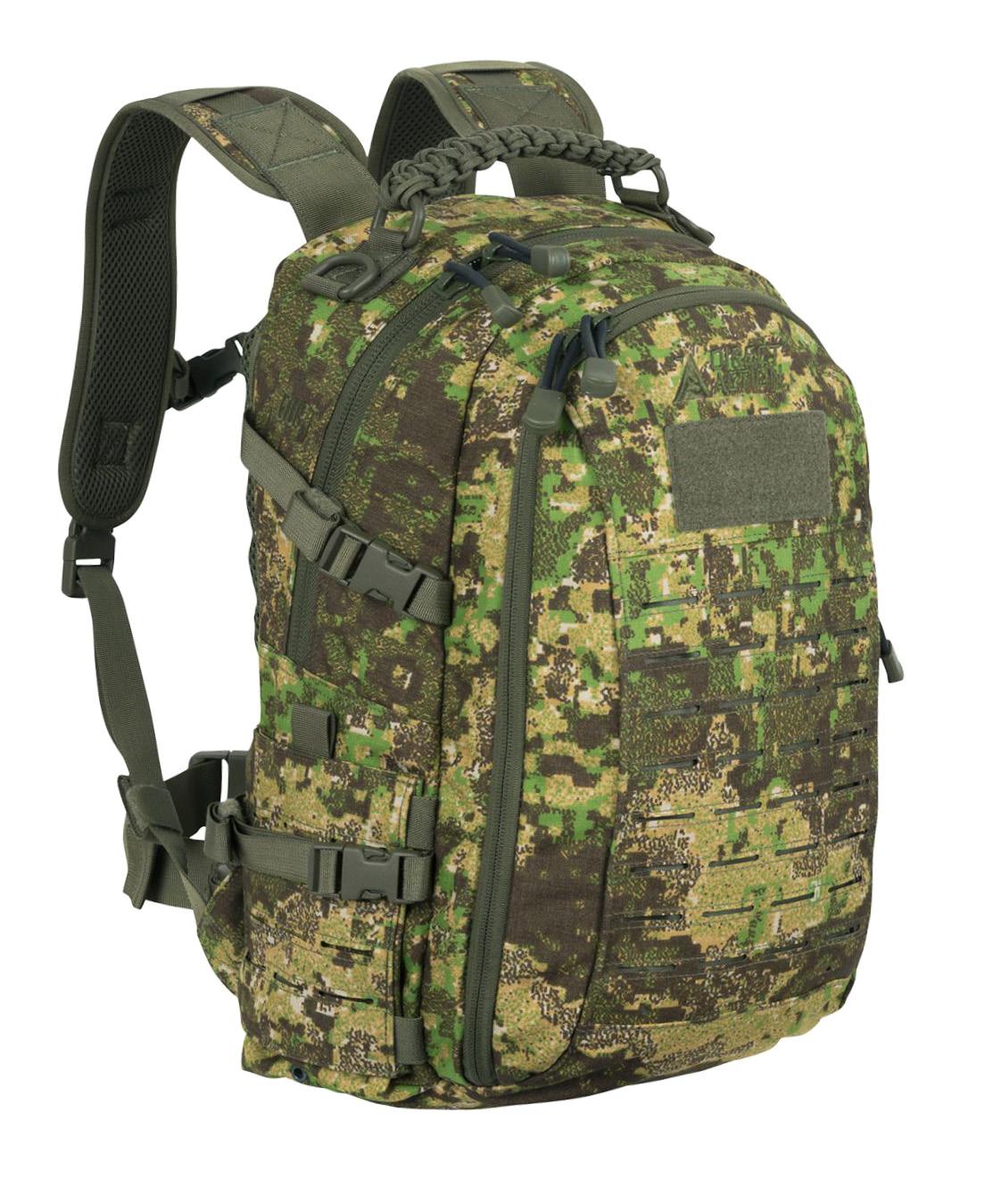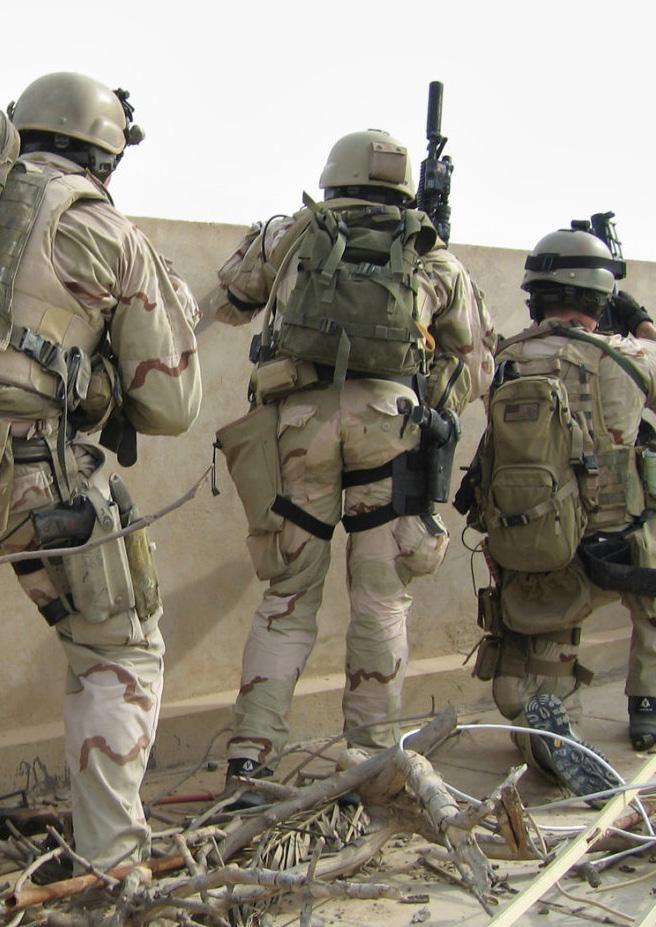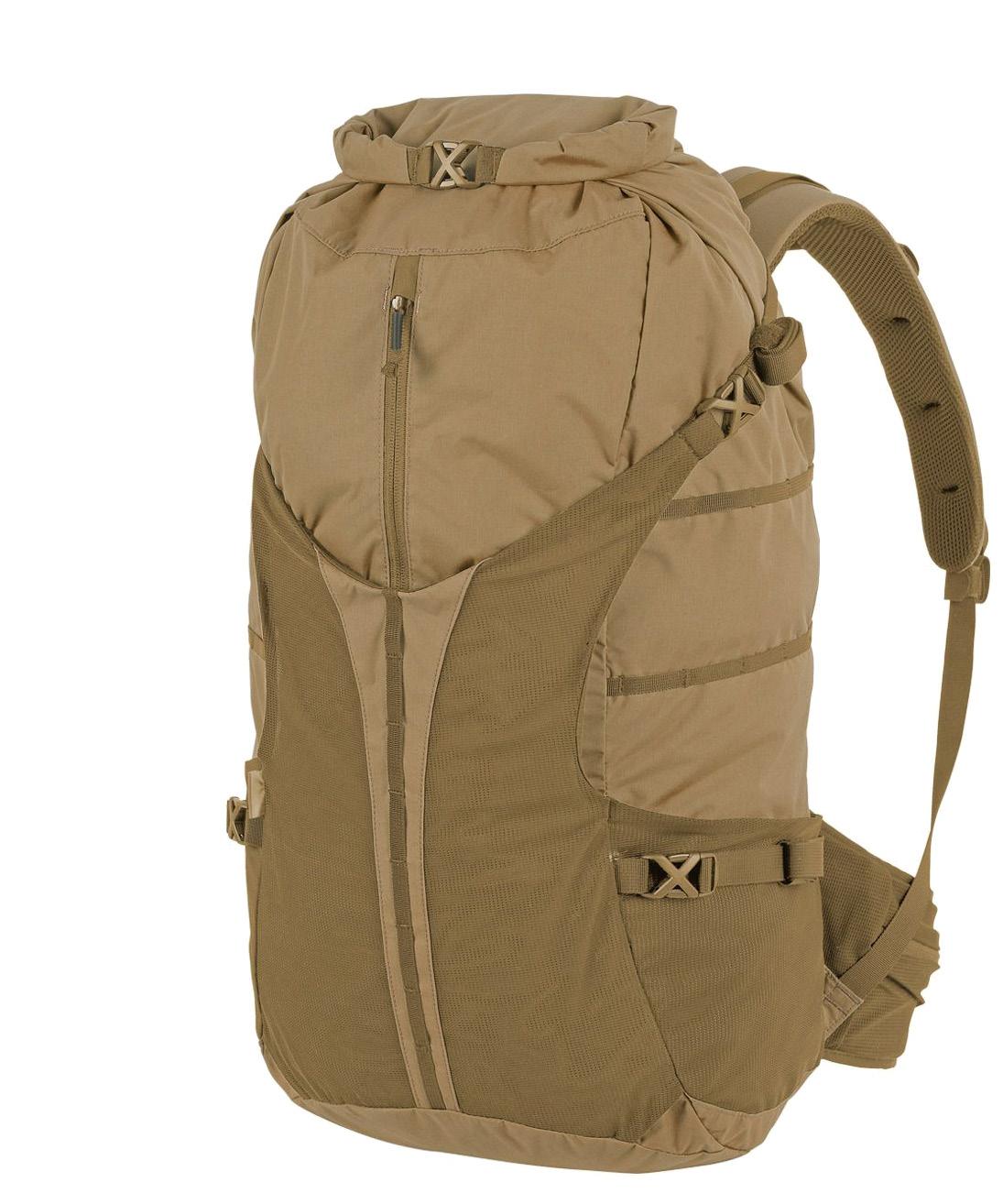
14 minute read
TOD: PACKS
PACKING IT IN!
WHY TRY TO REINVENT THE WHEEL WHEN IT’S ALREADY ROUND AND WORKS? THIS MONTH JON HANDS OVER THE TOD COLUMN TO OUR IN-HOUSE PACK EXPERT, BILL, TO RETURN TO THE CRUCIAL AREA OF WHAT PACK YOU NEED, AND WHAT YOU SHOULD BE LOOKING FOR IN TERMS OF FEATURES TO CARRY YOUR SUSTAINMENT LOAD SAFELY AND SECURELY!
It’s a whole new airsoft year, and this one is perhaps even more important than the many that have gone before! It finally looks like we’ve got ahead of the “covid curve” and that some normality will be returning to our lives; of course this mean that airsoft games and events will be coming back online in force, and we may even be able to travel overseas to attend the best and biggest of airsoft events again! I always get a little tingle of excitement as a whole new year beckons, and of course this summer looks to be even more exciting than usual as hopefully the lockdowns will end and we can FINALLY get back to playing at full speed… Hi-speed, lo-drag baby!
I’ve been lucky enough over the years to have played weekend games that have encompassed military training areas in the UK and USA, vast tracts of forest woodland, French mountains, and even former monastery buildings on Crete, and a good “weekender event” to me is the best possible form for an airsoft game as not only will it usually give two (or possibly even more!) full days, possibly with a night game thrown in, but it will also give me an opportunity to catch up with fellow players from different parts of the world! Stories will be told, tactics from the day will be analysed, new kit will be discussed and rated, and new RIFs will be drooled over; it’s always great fun, especially if it’s warm and fair, and the evenings are mild.
But of course we must always be prepared for every eventuality, and the preparation of our gear, what we carry, and how we carry it must always be a primary consideration. I’m going to come straight out and say this, I’m a pack monster! Call it what you will, pack, backpack, ruc, rucsac, or load-lugger, it’s all the same to me, but in my opinion EVERY airsofter worth their salt should be able to carry all they need for a day game, and indeed if you’re into MilSim I don’t believe you can consider yourself “full on” unless you own a pack that’s able to keep you in the field for multiple days!
I worked for many years for one of the very best pack makers in the outdoor industry before I decided to devote myself entirely to airsoft and tactical, so you could say I know a thing or three about how a pack should be put together, how it should be fitted, and indeed how it should be packed and used. I’ve spent many, many days with different packs on my own back, and covered lots of miles in the wild places of the world with my life strapped to my back.

I’ve seen many cheap packs fail, and many people end up in a world of hurt due to this, or to poor fitment. A badly fitting back will sit wrong and lead to fatigue very quickly, and the way you carry items inside will also have a bearing, but that’s a topic for another day, and Jon and I will work on that for a future article. Choosing the best pack is a difficult and personal thing, and there is no single definitive answer as to what will be best for you, but ultimately it’s all about getting the job done safely and efficiently; there is simply “no one fits all” pack that will suit every individual or scenario, and it all really comes down to how you’re planning to use it.
LOAD UP!
As I’ve said many times before, and I’ll return to here again, for any game that’s going to involve more than you can carry in your pockets or your first and second line gear, you’re going to need a pack! Even a sustainment pack fitted to the back of your plate carrier will help, and as much as I love these, I will usually opt for a standalone pack for a number of reasons. You may think that “all packs are equal” but they actually have lots of functional differences. I am of the opinion that even one pack will not be adequate for all scenarios, and even as a believer in “light is right” I have multiple packs for different scenarios; having two to three dedicated packs can cover you for pretty much any scenario you find yourself in, and although you can wing it with a single model, having more than one allows you more choice, and more tactical flexibility. What I mean by this is simply how you’re going to carry your gear. At many weekenders you’ll be able to camp directly next, or at very least close to the vehicle you arrived in so you can have your kit packed and organised in a large haul bag. However, there are some games where you will crash out in buildings onsite overnight and this will often mean that you need to carry everything on your back; indeed part of the scenario itself may involve you actually making a march in to a FOB site which will become your “home” for the duration so not only do you need to haul your gear in, but you need to keep it squared away too. Therefore your very first consideration must be some form of pack. Over the years I’ve seen some utterly terrible sights, with guys turning up for a game absolutely overloaded with goodies that they “might need”; I’m sure we’ve all seen that meme with the guy hauling the ruc that is bigger than he is and had a good laugh at that, but the truth is that there are many players out there who really shouldn’t be laughing, instead looking to their own personal admin and preparation of their load.
Are you a player that likes to cover all the bases, one that is prepared for any kind of weather that “Old Ma Nature” may throw at you, the player that’s prepared to bivvy at the drop of a hat? Are you a “lone wolf” or are you part of a team? To begin to work out what size and type of pack is right for you, first think about the following: • Fit: This is paramount to me for a tactical pack; if it weren’t I could just drag around a big old trash bag containing my worldly goods! • Role: How you’ll use the your pack, and in what setting, can will give you an idea of the features you’ll need • Capacity: Just HOW MUCH gear are you going to be lugging (ask yourself why; do you REALLY need it all!) • Features: How many compartments do you need, and why? How easy is the pack to access? How easy is it to dump if you need to bug out fast? • Packs come in all sizes, absolutely humongous, big, and small, so when you’re thinking about what you need to buy, REALLY think about what you need to have in it. Can the pack swallow up a bottle of BBs, a bottle of gas, some snacks, and water for a day game? Will it be large enough to carry and extra layer and your waterproofs on a bad-weather day? Do you need to carry any specialist items like comms and overnight equipment? Let’s look at things by size first! • Up to 10 litres : These can be great for a skirmish game where you just need to have a few choice essentials, and are usually pretty stable as most models will be designed for



hi-speed pursuits where little bulk or weight is really carried. They’re great if you can head back to the Safe Zone whenever you need to, but at any other time you’ll be wanting something bigger! • 10–20 litres: This is my “go to size” if I’m going to be working close to a FOB or from vehicles, as generous re-supply will still be relatively close at hand. At the larger end of this spectrum a 20 litre pack will let you carry additional shell garments, a more substantial
FAK, and more food and water so you can sustain yourself for a longer period if needed • 20–50 litres: When it comes to multi-day events and scenarios then this is where I look to have enough packed on my back to last, with occasional re-supply of rations and water, for some considerable time! I’ve gone into packing lists for multi-day scenarios before, but the 40-45 litre mark is where this really clicks into gear for me; you can go smaller if you’re REALLY super-minimalist, but around 40 litres is the absolute sweet spot as far as I’m concerned!
STABILITY FOR THE WIN
You’ll find that many smaller, lightweight packs do an excellent job of adapting to the shape of your back, and if you’re in 0-20 litre territory you can make do with very little mechanical support as part of the pack construction. When you move up in size, and therefore potentially in the weight that you may carry though, you need a little help to get the right fit and correct support that will help you avoid discomfort and fatigue! Many mid-size packs have an internal frame that helps support the weight you’re carrying; some will have plastic parts that add lightweight structure, whilst others will make use of alloy rods or staves to support the load. Bottom line; the sturdier the frame, the more the pack, and you, can handle!
But the framework of the pack is only the beginning of getting the “fit” right, and your pack should be as individual in how it interacts with your body as you are! A good pack “fit” will give you the correct size appropriate for your torso length (NOT your height), and will offer support via the hip belt which should be a snug fit if it’s a padded version such as those you’ll find on larger models; for the smaller, low-volume, lowweight packs the hip belt can be more minimal and is really there for stability.
You’ll find that some packs are available in multiple sizes to fit a range of torso lengths, and that ranges vary by manufacturer and by gender. While trying framepacks on, position the hip belt so the top edge is just above your hips, then look at how the shoulder straps work on your back and shoulders themselves; with no weight in the pack, the straps should sit slightly proud of your shoulders, enough that you can slip a finger beneath without feeling pressure, as when you add weight the straps will be pulled down. If there is a big gap the pack is likely too long for you! If at all possible try on your potential new loadpartner with some weight in; most good stores will have weight bags specifically for this. Some packs feature an adjustable torso that lets you really dial-in the fit; if you struggle to find the right fit with other packs, consider one with an adjustable torso. This is also a good idea if you’ll be sharing the pack with someone too!
Hip belts on daypacks usually accommodate a wide range of hip sizes, so when trying a pack on, just make sure you can get the hip belt loose enough or snug enough to fit comfortably around your hips! Female-specific backpacks usually have dimensions that are generally shorter than on men’s or unisex packs, and hip belts and shoulder straps that are contoured with the female form in mind. Because

women’s packs have smaller frame sizes, they often work well for youngsters too.
On a good pack you’ll find additional features that will let you get it set up specifically for you, and one to ensure that you have, whatever the size of the pack may be, is a Sternum Strap! This mid-chest strap found on most packs allows you to draw in the shoulder straps, which in turn can boost your overall carry comfort and stability. This is particularly useful on uneven terrain where an awkward step or slip could cause your pack to shift to one side and throw you even further off-balance.
FIELD READY!
In the past the majority of packs were of a toploading design, and this has been around probably since the first pack was ever made! Items that you didn’t need until you set up your camp or overnight position were stuffed deep and dark inside, with quick-access items towards the top. However, time and technology moves ever on, and just because this is the way it was done “back then” isn’t the best or most useful way now!
My access preference has been changed in recent years thanks to the arrival of packs with front-openings, sometimes called panel or “clamshell” access. This design offers a main storage compartment that is accessed via a U-shaped zipper; when fully opened, the front panel can be moved completely aside, making it far easier to load and keep organised even when you’re searching for something deep inside. In addition some packs may feature base access to the interior in addition to a top or front opening. This can (sometimes) be handy for accessing gear or clothing at the bottom of your pack without having to take everything out first, but it’s certainly not on my “must have feature” list, especially now with “clamshell” designs.
Whatever your choice for access options, and this is part of the personal aspect of your pack, there’s a few more things that you can look for to make sure you have all the features you could possibly need, and I don’t just mean extra lines of MOLLE or a big Velcro section for your team/morale patches!
USEFUL features to look for are: • Hydration Compatibilty – most good packs now have an internal sleeve so that you can slip in a hydration reservoir, along with ports for the drinking hose (also useful for comms cabling!) • Mesh Back Panel: Some packs have a ventilated back panel made of mesh that’s constructed so the pack rides along a few inches away from you back. This allows a steady flow of air to combat getting a sweaty back, and allows breathable clothing to at least have a chance of working properly! • Sleeping Bag Compartment – At the larger end of the Patrol pack spectrum some olderstyle top-loaders will still have zip access to a sleeping bag compartment at the bottom of the pack. Frankly this is something I can do without, as my sleeping bag only ever comes out when I’m hunkering down at the end of the day! • Raincover – If, like me, you live and play in an area where “liquid sunshine” is a regular occurrence this is a great feature to have! Trust me, most packs ARE NOT waterproof, and even if you have your gear stored in drybags, a raincover will stop the pack fabric from wetting out and gaining weight!
Whatever features you decide will be right for you will be exactly that, RIGHT for YOU, and don’t let anyone tell you that a feature is wrong if YOU find it useful! Decide what you need your pack for, what really NEEDS to go on it, and buy accordingly. If there’s one thing to get right, it’s the fit. Don’t be swayed by a pack just because it’s in the right camo pattern to match the rest of you oh-so-gucci-gear, find one that fits you properly that you can carry all day long if you need to! As always, I’d suggest trying a pack before you buy, but once you know what you need you can buy with confidence each and every time!
My thanks go to www.military1st.co.uk for the product images shown with this article, and if you’re in need of a good pack then head on over to take a look at the extensive range they have on offer from some superb brands! AA













